Investigation of the Enhancement of Boiling Heat Transfer Performance Utilizing a Hybrid Wetting Surface with a Macroscopic Millimeter-Scale Pillar Array
Abstract
1. Introduction
2. Hybrid Wetting Surface Preparation and Boiling Experiment Measurement
2.1. Hybrid Wetting Surface Preparation
2.2. Boiling Heat Transfer Measurements
3. Numerical Method for Bubble Growing
3.1. Condensation and Evaporation Model
3.2. Validation of the Numerical Method Using Bubble Growth Dynamics on a Flat Surface
3.3. Geometric Model and Grid Independence Study
4. Results and Discussion
4.1. Analysis of the Experimental Data
4.2. Analysis of Numerical Results
5. Conclusions
Supplementary Materials
Author Contributions
Funding
Institutional Review Board Statement
Informed Consent Statement
Data Availability Statement
Conflicts of Interest
References
- Li, W.; Dai, R.K.; Zeng, M.; Wang, Q.Q. Review of two types of surface modification on pool boiling enhancement: Passive and active. Renew. Sustain. Energy Rev. 2020, 130, 109926. [Google Scholar] [CrossRef]
- Singh, S.K.; Sharma, D. Review of pool and flow boiling heat transfer enhancement through surface modification. Int. J. Heat Mass Transf. 2021, 181, 122020. [Google Scholar] [CrossRef]
- Allred, T.P.; Weibel, J.A.; Garimella, S.V. Enabling Highly Effective Boiling from Superhydrophobic Surfaces. Phys. Rev. Lett. 2018, 120, 174501. [Google Scholar] [CrossRef] [PubMed]
- Allred, T.P.; Weibel, J.A.; Garimella, S.V. The petal effect of parahydrophobic surfaces offers low receding contact angles that promote effective boiling. Int. J. Heat Mass Transf. 2019, 135, 403–412. [Google Scholar] [CrossRef]
- Betz, A.R.; Xu, J.; Qiu, H.; Attinger, D. Do surfaces with mixed hydrophilic and hydrophobic areas enhance pool boiling? Appl. Phys. Lett. 2010, 97, 141909. [Google Scholar] [CrossRef]
- Betz, A.R.; Jenkins, J.; Kim, C.J.; Attinger, D. Boiling heat transfer on superhydrophilic, superhydrophobic, and superbiphilic surfaces. Int. J. Heat Mass Transf. 2013, 57, 733–741. [Google Scholar] [CrossRef]
- Deng, Z.L.; Liu, X.D.; Wu, S.C.; Zhang, C.B. Pool boiling heat transfer enhancement by bi-conductive surfaces. Int. J. Therm. Sci. 2021, 167, 107041. [Google Scholar] [CrossRef]
- Rahman, M.M.; Pollack, J.; McCarthy, M. Increasing Boiling Heat Transfer using Low Conductivity Materials. Sci. Rep. 2015, 5, 13145. [Google Scholar] [CrossRef]
- Hou, K.Y.; Li, X.Y.; Li, Q.; Cheni, X.M. Tunable Wetting Patterns on Superhydrophilic/Superhydrophobic Hybrid Surfaces for Enhanced Dew-Harvesting Efficacy. Adv. Mater. Interfaces 2020, 7, 1901683. [Google Scholar] [CrossRef]
- Egab, K.; Alwazzan, M.; Peng, B.; Oudah, S.K.; Khan, J.; Li, C. Patten shape effects on condensation on hybrid-wetting surfaces. Appl. Therm. Eng. 2022, 212, 118614. [Google Scholar] [CrossRef]
- Shen, B.; Hamazaki, T.; Ma, W.; Iwata, N.; Hidaka, S.; Takahara, A.; Takahashi, K.; Takat, Y. Enhanced pool boiling of ethanol on wettability-patterned surfaces. Appl. Therm. Eng. 2019, 149, 325–331. [Google Scholar] [CrossRef]
- Motezakker, A.R.; Sadaghiani, A.K.; Çelik, A.S.; Larsen, T.; Villanueva, L.G.; Kosar, A. Optimum ratio of hydrophobic to hydrophilic areas of biphilic surfaces in thermal fluid systems involving boiling. Int. J. Heat Mass Transf. 2019, 135, 164–174. [Google Scholar] [CrossRef]
- Liao, M.J.; Duan, L.Q. Effect of the Hybrid Hydrophobic-Hydrophilic Nanostructured Surface on Explosive Boiling. Coatings 2021, 11, 212. [Google Scholar] [CrossRef]
- Guo, W.; Zeng, L.C.; Lu, Y.; Chen, J. Tuning surface hybrid-wettability to enhance the vapour film phenomenon induced by boiling heat transfer: Molecular dynamics. Int. Commun. Heat Mass Transf. 2022, 136, 106172. [Google Scholar] [CrossRef]
- Li, Q.; Yu, Y.; Zhou, P.; Yan, H.J. Enhancement of boiling heat transfer using hydrophilic-hydrophobic mixed surfaces: A lattice Boltzmann study. Appl. Therm. Eng. 2018, 132, 490–499. [Google Scholar] [CrossRef]
- Yu, Y.; Wen, Z.X.; Li, Q.; Zhou, P.; Yan, H.J. Boiling heat transfer on hydrophilic-hydrophobic mixed surfaces: A 3D lattice Boltzmann study. Appl. Therm. Eng. 2018, 142, 846–854. [Google Scholar] [CrossRef]
- Shen, C.; Zhang, C.C.; Bao, Y.C.; Wang, X.B.; Liu, Y.; Ren, L.Q. Experimental investigation on enhancement of nucleate pool boiling heat transfer using hybrid wetting pillar surface at low heat fluxes. Int. J. Therm. Sci. 2018, 130, 47–58. [Google Scholar] [CrossRef]
- Son, G.; Dhir, V.K.; Ramanujapu, N. Dynamics and heat transfer associated with a single bubble during nucleate boiling on a horizontal surface. J. Heat Transf. 1999, 121, 623–631. [Google Scholar] [CrossRef]
- Nam, Y.; Aktinol, E.; Dhir, V.K.; Ju, Y.S. Single bubble dynamics on a superhydrophilic surface with artificial nucleation sites. Int. J. Heat Mass Transf. 2011, 54, 1572–1577. [Google Scholar] [CrossRef]
- Zhang, L.; Li, Z.D.; Li, K.; Li, H.X.; Zhao, J.F. Influence of heater thermal capacity on bubble dynamics and heat transfer in nucleate pool boiling. Appl. Therm. Eng. 2015, 88, 118–126. [Google Scholar] [CrossRef]
- Klostermann, J.; Schaake, K.; Schwarze, R. Numerical simulation of a single rising bubble by VOF with surface compression. Int. J. Numer. Methods Fluids 2013, 71, 960–982. [Google Scholar] [CrossRef]
- Hoang, D.A.; Steijn, V.V.; Portela, L.M.; Kreutzer, M.T.; Kleijn, C.R. Benchmark numerical simulations of segmented two-phase flows in microchannels using the Volume of Fluid method. Comput. Fluids 2013, 86, 28–36. [Google Scholar] [CrossRef]
- Shen, C.; Zhang, C.C.; Gao, M.H.; Li, X.L.; Liu, Y.Q.; Ren, L.Q.; Moita, A.S. Investigation of effects of receding contact angle and energy conversion on numerical prediction of receding of the droplet impact onto hydrophilic and superhydrophilic surfaces. Int. J. Heat Fluid Flow 2018, 74, 89–109. [Google Scholar] [CrossRef]
- Bond, M.; Struchtrup, H. Mean evaporation and condensation coefficients based on energy dependent condensation probability. Phys. Rev. E 2004, 70, 061605. [Google Scholar] [CrossRef]
- Kolasinski, K.W. Surface Science Foundations of Catalysis and Nanoscience, 3rd ed.; John Wiley & Sons Ltd.: Chichester, UK, 2012. [Google Scholar]
- Stewart, M. Pressurization of a Flightweight, Liquid Hydrogen Tank: Evaporation & Condensation at the Liquid/Vapor Interface. In Proceedings of the 53rd AIAA/SAE/ASEE Joint Propulsion Conference, Atlanta, GA, USA, 10–12 July 2017; pp. 1–13. [Google Scholar]
- Baniabedalruhman, A. Dynamic Meshing around Fluid-Fluid Interfaces with Applications to Droplet Tracking in Contraction Geometries. Ph.D. Thesis, Michigan Technological University, Houghton, MI, USA, 2015. [Google Scholar]
- Liao, Q.; Zhu, X.; Xing, S.M.; Wang, H. Visualization study on coalescence between pair of water drops on inclined surfaces. Exp. Therm. Fluid Sci. 2008, 32, 1647–1654. [Google Scholar] [CrossRef]
- Cheng, J.; Zhang, Y.; Pi, P.H.; Lu, L.; Tang, Y. Effect of gradient wetting surface on liquid flow in rectangular microchannels driven by capillary force and gravity: An analytical study. Int. Commun. Heat Mass Transf. 2011, 38, 1340–1343. [Google Scholar] [CrossRef]
- Lv, C.J.; Chen, C.; Chuang, Y.C.; Tseng, F.G.; Yin, Y.J.; Grey, F.; Zhen, Q.S. Substrate curvature gradient drives rapid droplet motion. Phys. Rev. Lett. 2014, 113, 026101. [Google Scholar] [CrossRef] [PubMed]
- Kunkelmann, C. Numerical Modeling and Investigation of Boiling Phenomena. Ph.D. Thesis, Technical University of Darmstadt, Darmstadt, Germany, 2011. [Google Scholar]
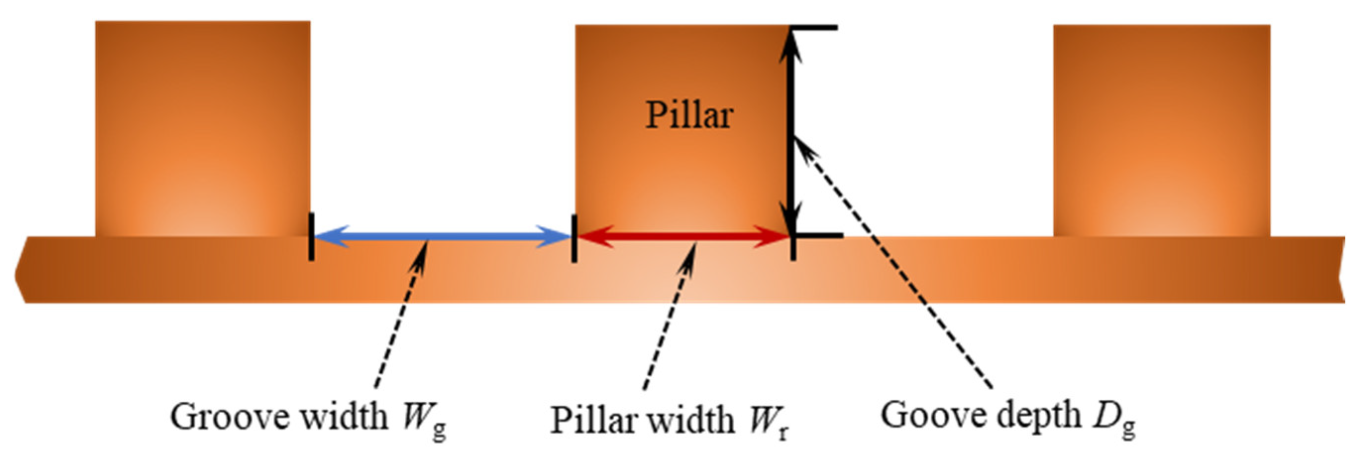


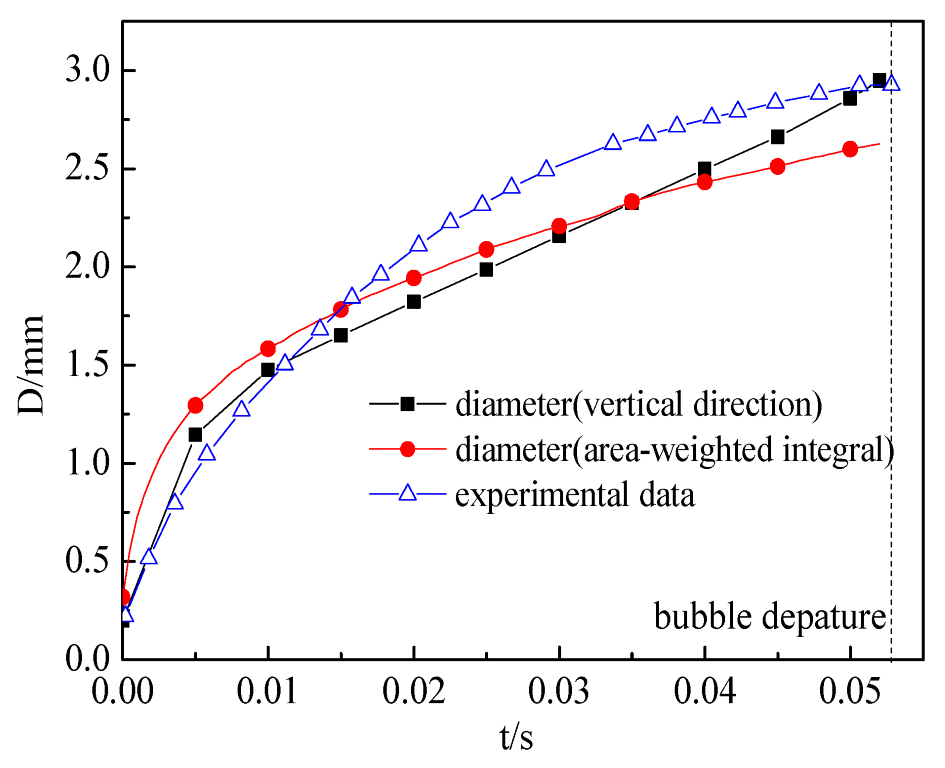
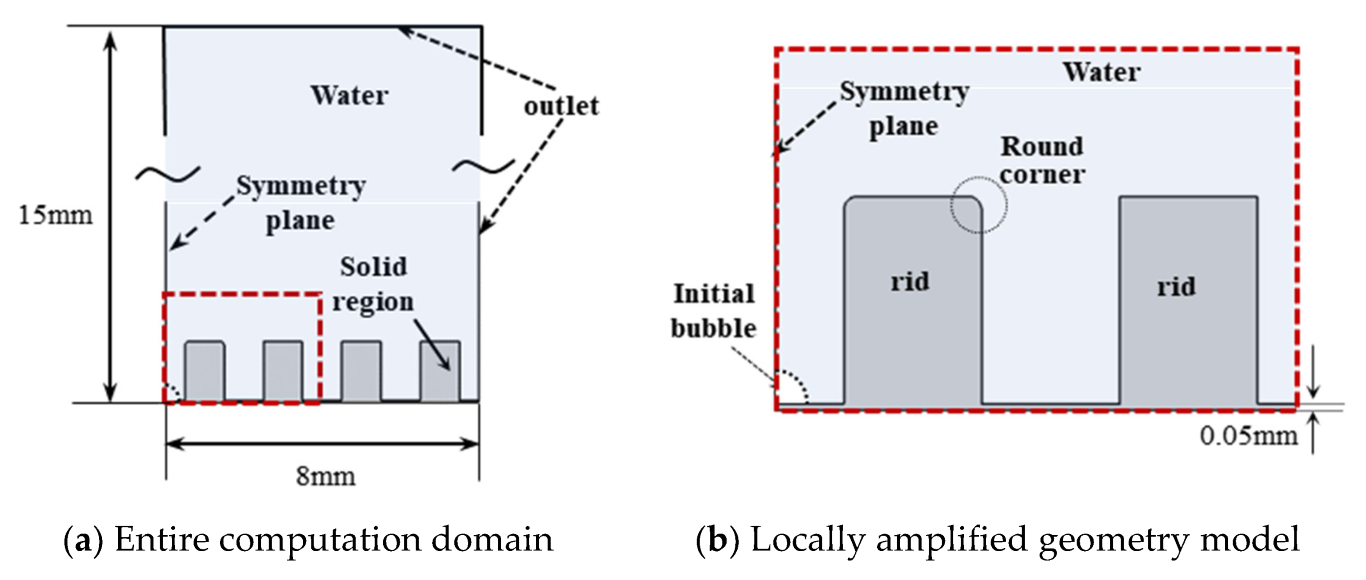

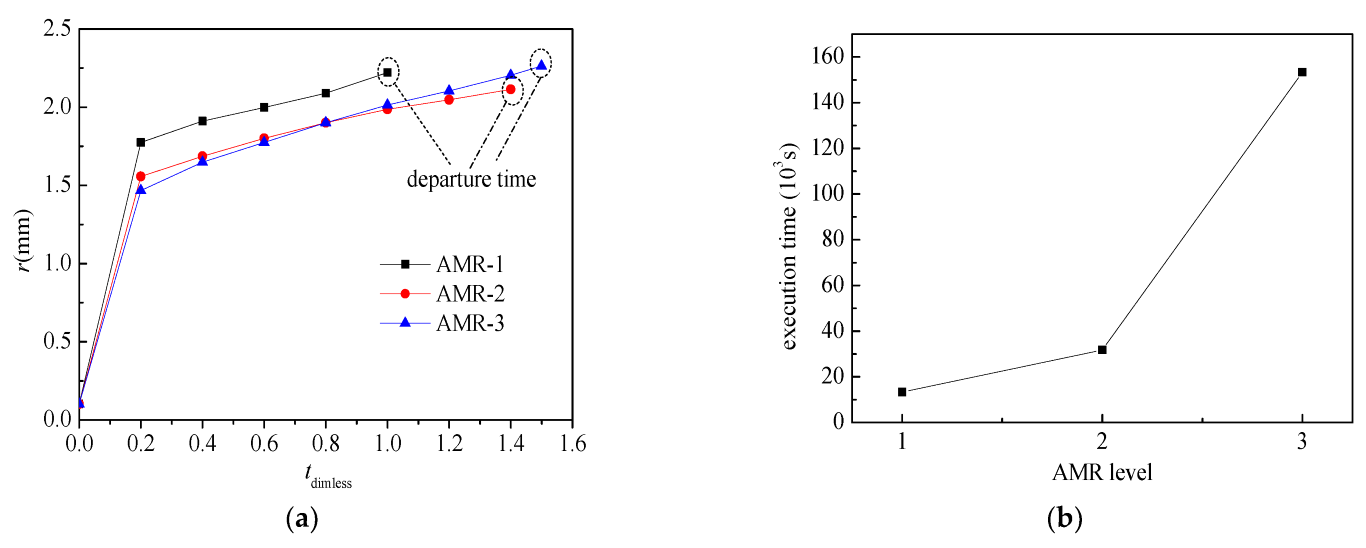
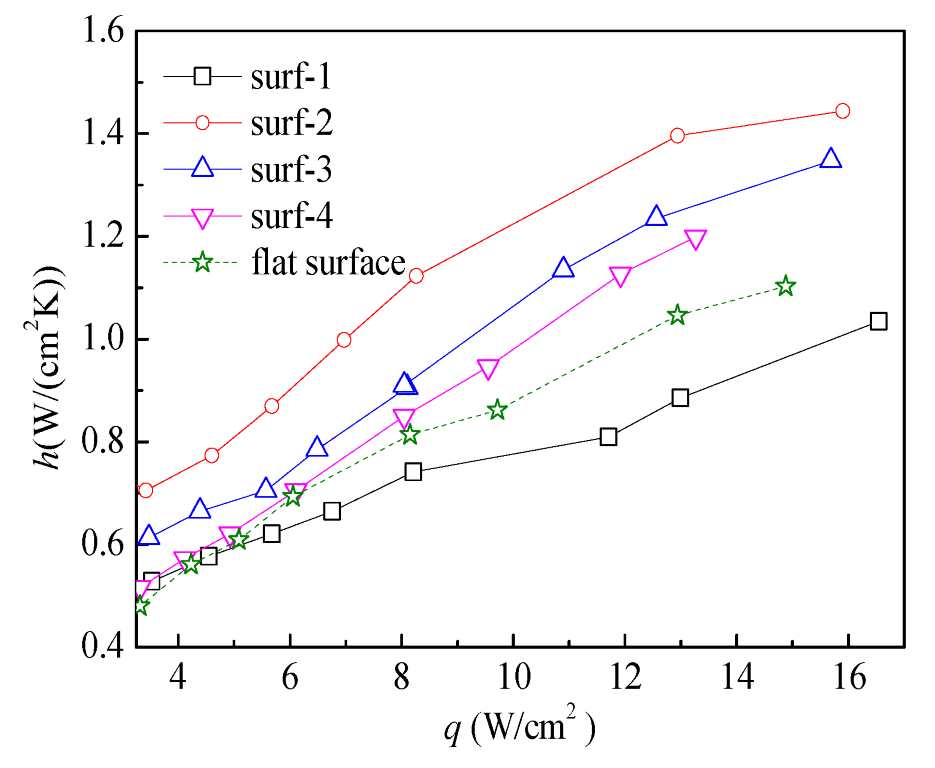

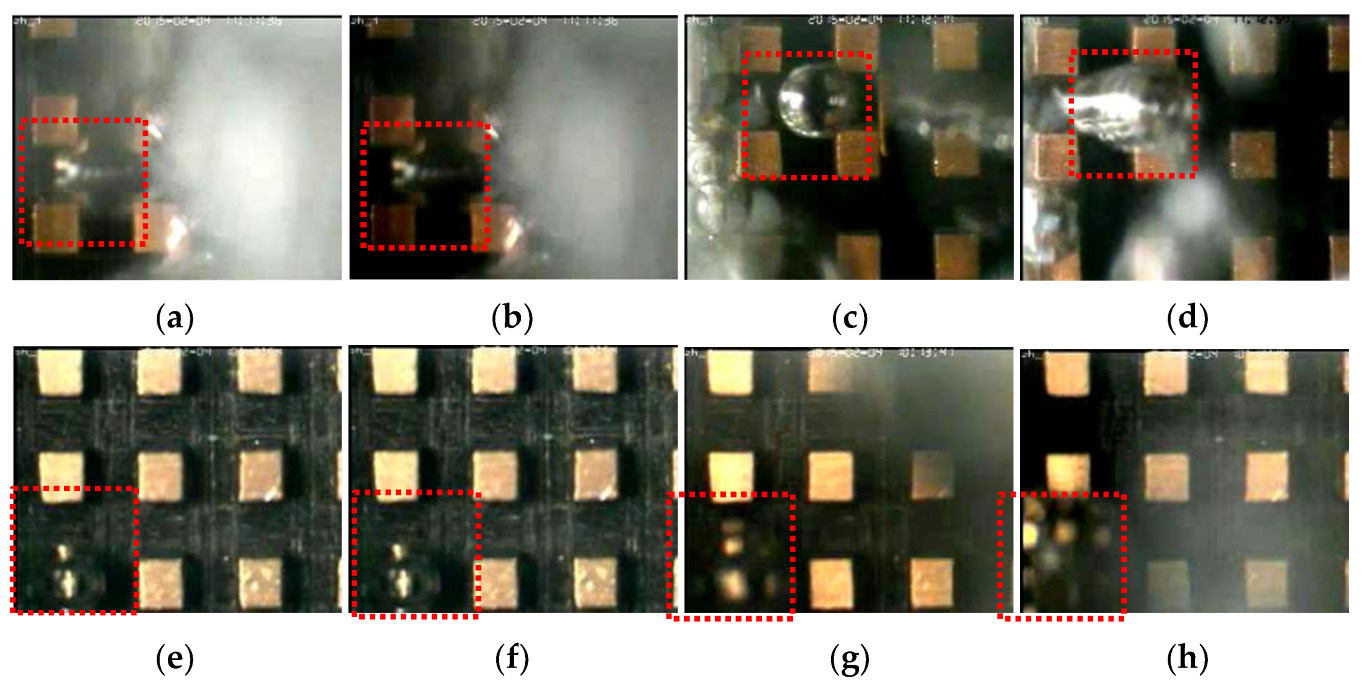


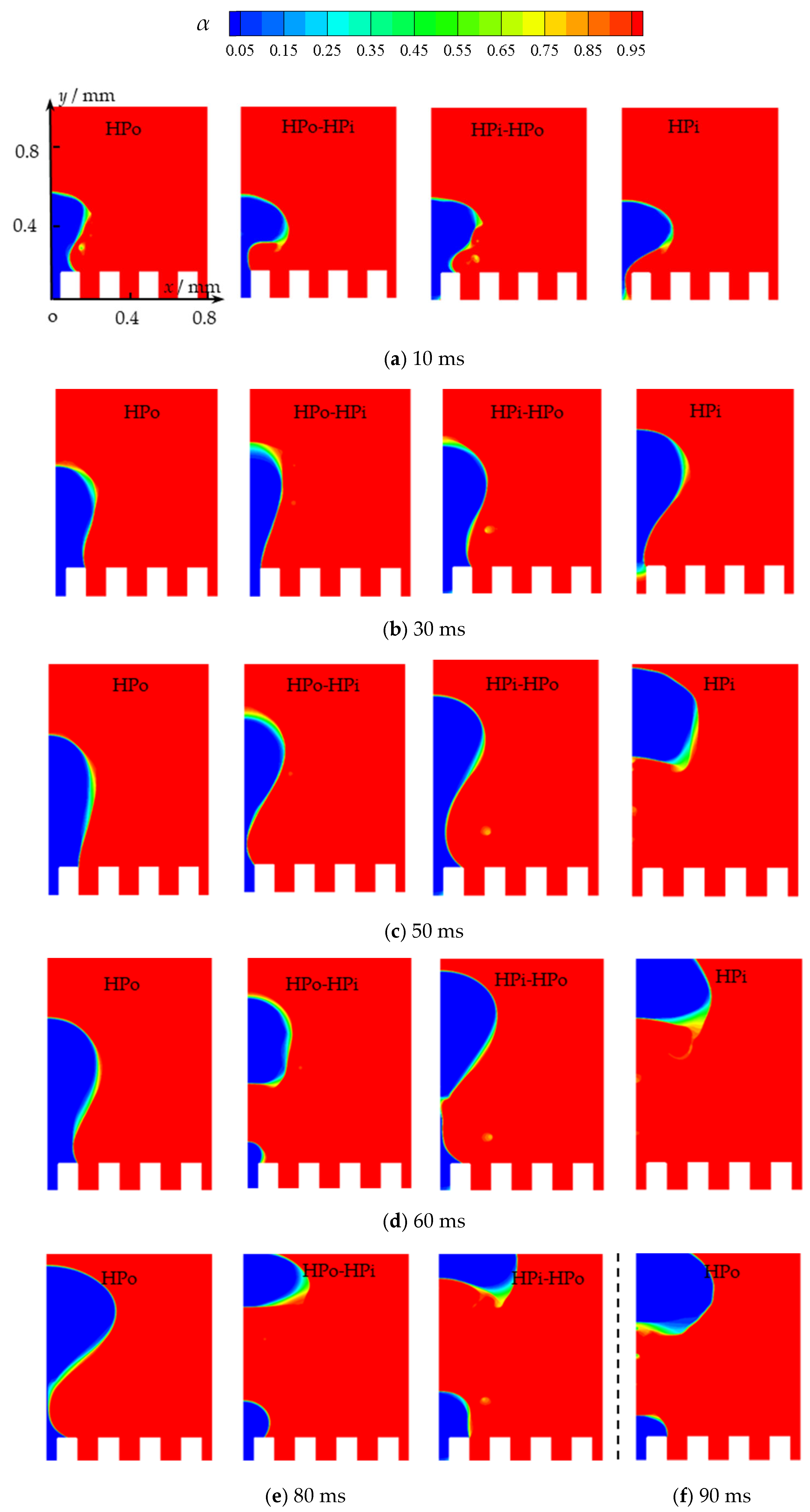

| Surface Name | Surf-1 | Surf-2 | Surf-3 | Surf-4 |
|---|---|---|---|---|
| Apparent contact angle θ (º) | 115 | 115-60 | 60-115 | 60 |
| Wettability Abbreviation for surface samples | HPo | HPo-HPi | HPi-HPo | HPi |
| Wettability on top face of pillar | HPo | HPi | HPo | HPi |
| Wettability on bottom face of pillar | HPo | HPo | HPi | HPi |
| Groove width (mm) between pillars Wg | 1.0 | 1.0 | 1.0 | 1.0 |
| Pillar width (mm) Wr | 1.0 | 1.0 | 1.0 | 1.0 |
| Groove depth (mm) Dg | 1.5 | 1.5 | 1.5 | 1.5 |
| Surface Name | Surf-1 | Surf-2 | Surf-3 | Surf-4 | Flat Surface |
|---|---|---|---|---|---|
| Representative abbreviated name | HPo | HPo-HPi | HPi-HPo | HPi | HPi |
| Heat transfer coefficient h (W/(cm2 K)) | 0.86 | 1.35 | 1.20 | 1.16 | 1.01 |
| Surface Name | Surf-1 | Surf-2 | Surf-3 | Surf-4 | Flat-1 | Flat-2 |
|---|---|---|---|---|---|---|
| Contact angle θ (º) | 120 | 120-60 | 60-120 | 60 | 120 | 60 |
| Departure time (ms) | 80 | 50 | 60 | 40 | 120 | 120 |
| Area (mm2) | 17.5 | 8.32 | 13.5 | 12.4 | 26.0 | 5.51 |
| Radius (mm) | 2.36 | 1.63 | 2.07 | 1.99 | 2.88 | 1.32 |
Disclaimer/Publisher’s Note: The statements, opinions and data contained in all publications are solely those of the individual author(s) and contributor(s) and not of MDPI and/or the editor(s). MDPI and/or the editor(s) disclaim responsibility for any injury to people or property resulting from any ideas, methods, instructions or products referred to in the content. |
© 2023 by the authors. Licensee MDPI, Basel, Switzerland. This article is an open access article distributed under the terms and conditions of the Creative Commons Attribution (CC BY) license (https://creativecommons.org/licenses/by/4.0/).
Share and Cite
Shen, C.; Xu, D.; Wei, B.; Zhang, C.; Du, S.; Zhao, T. Investigation of the Enhancement of Boiling Heat Transfer Performance Utilizing a Hybrid Wetting Surface with a Macroscopic Millimeter-Scale Pillar Array. Sustainability 2023, 15, 7920. https://doi.org/10.3390/su15107920
Shen C, Xu D, Wei B, Zhang C, Du S, Zhao T. Investigation of the Enhancement of Boiling Heat Transfer Performance Utilizing a Hybrid Wetting Surface with a Macroscopic Millimeter-Scale Pillar Array. Sustainability. 2023; 15(10):7920. https://doi.org/10.3390/su15107920
Chicago/Turabian StyleShen, Chun, Dongjun Xu, Bo Wei, Chengchun Zhang, Shenghua Du, and Tian Zhao. 2023. "Investigation of the Enhancement of Boiling Heat Transfer Performance Utilizing a Hybrid Wetting Surface with a Macroscopic Millimeter-Scale Pillar Array" Sustainability 15, no. 10: 7920. https://doi.org/10.3390/su15107920
APA StyleShen, C., Xu, D., Wei, B., Zhang, C., Du, S., & Zhao, T. (2023). Investigation of the Enhancement of Boiling Heat Transfer Performance Utilizing a Hybrid Wetting Surface with a Macroscopic Millimeter-Scale Pillar Array. Sustainability, 15(10), 7920. https://doi.org/10.3390/su15107920







